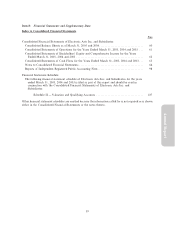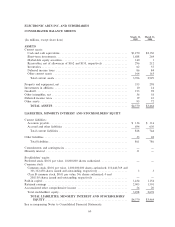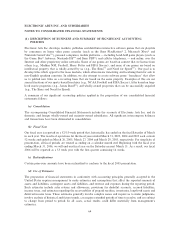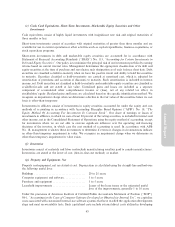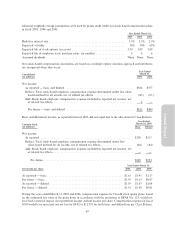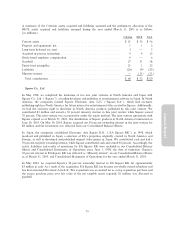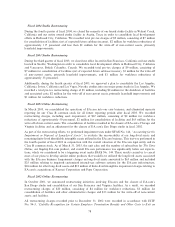Electronic Arts 2005 Annual Report Download - page 124
Download and view the complete annual report
Please find page 124 of the 2005 Electronic Arts annual report below. You can navigate through the pages in the report by either clicking on the pages listed below, or by using the keyword search tool below to find specific information within the annual report.(l) Sales Returns and Allowances and Bad Debt Reserves
We estimate potential future product returns, price protection and stock-balancing programs related to current
period product revenue. We analyze historical returns, current sell-through of channel partner inventory of our
products, current trends in the software games business segment and the overall economy, changes in
customer demand and acceptance of our products and other related factors when evaluating the adequacy of
the sales returns and price protection allowances. In addition, we monitor the volume of sales to our channel
partners and monitor their inventories as substantial overstocking in the distribution channel could result in
high returns or higher price protection costs in subsequent periods.
Similarly, signiÑcant judgment is required to estimate our allowance for doubtful accounts in any accounting
period. We analyze customer concentrations, customer credit-worthiness and current economic trends when
evaluating the adequacy of the allowance for doubtful accounts.
(m) Advertising Costs
We generally expense advertising costs as incurred, except for production costs associated with media
campaigns which are recognized as prepaid assets (to the extent paid in advance) and expensed at the Ñrst run
of the advertisement. Cooperative advertising with our channel partners is accrued when revenue is recognized
and such amounts are included in marketing and sales expense if there is a separate identiÑable beneÑt for
which we can reasonably estimate the fair value of the beneÑt identiÑed. Otherwise, they are recognized as a
reduction of net revenue. We then reimburse the channel partner when qualifying claims are submitted. For
the Ñscal years ended March 31, 2005, 2004 and 2003, advertising expenses totaled approximately $174 mil-
lion, $183 million and $152 million, respectively. We sometimes receive vendor reimbursements for
advertising costs from our vendors, and such amounts are recognized as a reduction of marketing and sales
expense if there is a separate identiÑable beneÑt for which we can reasonably estimate the fair value of the
beneÑt identiÑed. Otherwise, they are recognized as a reduction of cost of goods sold. Included in marketing
and sales expense are vendor reimbursements of advertising expenses of $42 million, $45 million, and
$28 million for the Ñscal years ended March 31, 2005, 2004, and 2003, respectively.
(n) Software Development Costs
Research and development costs, which consist primarily of software development costs, are expensed as
incurred. SFAS No. 86, ""Accounting for the Cost of Computer Software to be Sold, Leased, or Otherwise
Marketed'', provides for the capitalization of certain software development costs incurred after technological
feasibility of the software is established or for development costs that have alternative future uses. Under our
current practice of developing new products, the technological feasibility of the underlying software is not
established until substantially all product development is complete, which generally includes the development
of a working model. The software development costs that have been capitalized to date have been
insigniÑcant.
(o) Stock-based Compensation
We account for stock-based awards to employees using the intrinsic value method in accordance with APB
No. 25, ""Accounting for Stock Issued to Employees''. We have adopted the disclosure-only provisions of
SFAS No. 123, ""Accounting for Stock-Based Compensation'', as amended.
Had compensation cost for our stock-based compensation plans been measured based on the estimated fair
value at the grant dates in accordance with the provisions of SFAS No. 123, we estimate that our reported net
income and net income per share would have been the pro forma amounts indicated below. The fair value of
each option grant is estimated on the date of grant using the Black-Scholes option-pricing model. The
68



